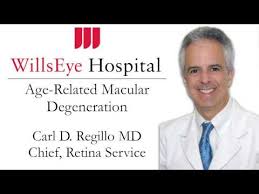
30 Jul Wet AMD: Genentech’s Port Delivery System Can Allow Longer Intervals Between Ranibizumab Treatments
MedicalResearch.com Interview with:

Carl D. Regillo, MD, FACS
Chief, Retina Service
Wills Eye Hospital
MedicalResearch.com: What is the background for the Phase III Archway study? Would you briefly explain what Neovascular Age-Related Macular Degeneration means?
Genentech announced in late July the results from the Phase III Archway study evaluating Port Delivery System (PDS) with ranibizumab (PDS) in people living with neovascular or “wet” age-related macular degeneration (nAMD) which showed PDS enabled 98.4% of people to go six months between treatments, while achieving vision outcomes equivalent to those receiving monthly ranibizumab eye injections, a current standard of care.
AMD is a condition that affects the part of the eye that provides sharp, central vision needed for activities like reading and is a leading cause of blindness for people age 60 and over in the U.S. Neovascular AMD is an advanced form of AMD that can cause rapid and severe vision loss. Approximately 11 million people in the United States have some form of AMD and of those, about 1.1 million have nAMD.
MedicalResearch.com: Would you also briefly explain how Lucentis® (ranibizumab injection) works in this disease? How is Lucentis® currently administered?
Ranibizumab is designed to bind to and inhibit VEGF-A, a protein that is believed to play a critical role in the formation of new blood vessels and the leakiness of the vessels. Lucentis is administered by intravitreal injection into the eye. While effective, many people with nAMD need to get eye injections as often as monthly, which can be a difficult treatment schedule for patients and their caregivers to maintain.
It’s important to note that PDS contains a customized formulation of ranibizumab that is different from the Lucentis injection.
MedicalResearch.com: What are the main findings of the study? Is less medication required with the implant? Is there less wastage of the drug? Potential complications?
- In Archway, nearly all (98.4%) people with nAMD treated with PDS were able to go six months without needing additional treatment while still achieving equivalent vision improvements as Lucentis injections.
- PDS is a permanent refillable eye implant, approximately the size of a grain of rice, which continuously delivers a customized formulation of ranibizumab over a period of months. This delivery method is distinct from that of existing standard of care anti-VEGF treatments, such as ranibizumab injection, administered by injection into the eye.
- Safety data from the study support a favorable benefit-risk profile for PDS. The PDS implant insertion surgery and refill-exchange procedures were generally well tolerated, and the systemic safety of PDS was comparable to monthly ranibizumab injections.
MedicalResearch.com: What should readers take away from your report?
- PDS is the first Phase III nAMD therapy shown to allow patients to go six months between treatments, while achieving vision outcomes equivalent to monthly treatments. PDS could potentially alleviate the treatment burden for people with nAMD by reducing treatment visits from as many as 12 per year to two per year.
- The current standard of care for nAMD can be burdensome because it requires patients to visit their ophthalmologist for eye injections of anti-VEGF therapy as often as once a month to help maintain vision gains and/or prevent vision loss. This high treatment burden of anti-VEGF therapy can lead to under-treatment of nAMD and, potentially, less than optimal vision outcomes.
MedicalResearch.com: Is there anything else you would like to add? Any disclosures?
- Based on these results, PDS could potentially reduce the number of treatments from as many as 12 per year to two per year for nAMD patients, without sacrificing efficacy. While effective therapies exist for this condition, I know from clinical experience that it can be difficult for patients and caregivers to commit to frequent treatments, and patients who are not treated frequently enough may be at risk of losing vision.
Disclosure: Dr. Regillo consults for Genentech and is a clinical investigator for the Archway trial.
Citation:
ASRS 2020 abstract:
https://www.asrs.org/annual-meeting
Primary Analysis Results of the Phase 3 Archway Trial of the Port Delivery System With Ranibizumab for Patients With Neovascular AMD
[wysija_form id=”3″]
[last-modified]
The information on MedicalResearch.com is provided for educational purposes only, and is in no way intended to diagnose, cure, or treat any medical or other condition. Always seek the advice of your physician or other qualified health and ask your doctor any questions you may have regarding a medical condition. In addition to all other limitations and disclaimers in this agreement, service provider and its third party providers disclaim any liability or loss in connection with the content provided on this website.
Last Updated on July 30, 2020 by Marie Benz MD FAAD
